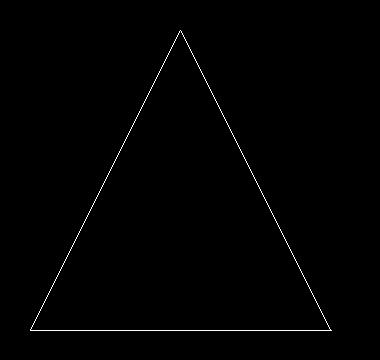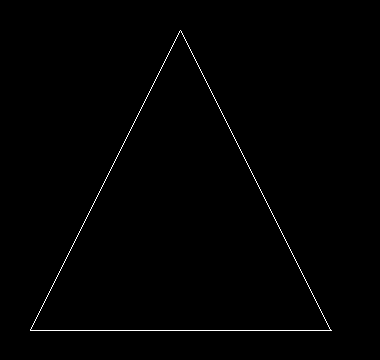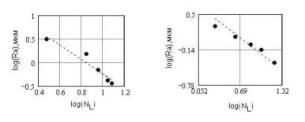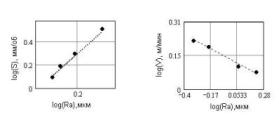|
||||||||||
|
FRACTAL
PROPERTIES OF MICROGEOMETRY OF
PROCESSED SURFACES
Research manager: Ph.D. Dr.
Matviyenko Andriy
As it is known creation of surfaces with the certain microgeometrical properties is one of the primary goals of mechanical engineering. Especially it concerns surfaces of particularly responsible products of avia-space technics, instrument making, precision machine-tool construction, etc. Moreover, the question of maintenance of microgeometry of a surface is especially actual at development of new technologies of processing of surfaces both mechanical, physical and chemical ways of processing in the field of micro-and nanotechnology. Quality of a surface is traditionally characterized by a roughness – an arithmetic mean deviation, the maximal height of roughness, average step of roughness of a structure, etc. and physicomechanical properties of a superficial layer []. The roughness of a surface, as many researchers have shown, is one of the basic parameters of quality of a surface. In many cases the microgeometry of a superficial layer predetermines behaviour of a surface during its operation, and in case of micro- and nanotechnology the roughness is considered not as secondary structure, but as a property of the structure of material. As a rule, the microgeometry of a superficial layer is considered as a certain static object which was generated during some influence. Classically in processing of materials by cutting the roughness is a geometrical prototype of a trajectory of moving of the tool which is set by kinematics and modes of processing. On the other hand in the processing power, temperature and other fields are formed, there is a chemical influence on a surface, there are high pressures in a zone of contact of the tool and a processable surface, movement of dispositions, etc. owing to what the structure of a superficial layer changes. Therefore formation of a surface on the whole and microgeometry in particular is a result of action of set of processes and not just merely geometrical "responses" of action of the tool as for example it is marked in the work [2]. Within the limits of the considered concept of "collective" formation of a roughness it is possible to tell that such object as the microgeometry of a surface is dynamic system. Studying of dynamic system assumes studying of its properties which are defined by some people invariants (for example, Lyapunov's parameter, entropy, etc.). Therefore in this case the use of classical geometrical parameters of a roughness is insufficient or simply impossible. Moreover, geometrical parameters do not display such important property of roughness as dynamic system – evolution. Thus, new approaches in an estimation of microgeometry of a surface are necessary and one of such approaches can be a use of the theory of fractals. Application of the theory of fractals will allow bringing of a new parameter for an estimation of a roughness, to create base not only for fractal classifications, but forecasting of change of microgeometry during its formation, both at a stage of processing by technological method, and at a stage of operation. The purpose of the given work is check of the introduced assumptions from positions of the theory of fractals on an example of formation of microgeometry of a surface at a stage of technological influences. Brief
positions of the theory of fractals In
general fractal is a geometrical object (a line, a surface, a
spatial body) described by irregularity (structures, geometry,
etc.), but self-similarity (or symmetry). Self-similarity means that
the object more or less is uniformly arranged [3,4]on various scales
of its consideration. That is the invariance of the basic
geometrical features of object is supposed at the change of the
scale. For
example, in figures formation(education) фрактальных
objects is shown by a method of iterations.
Naturally
there are borders of these scales connected with concept of final
"weight" of object. The irregularity of object, in
general, means its some fractional dimension distinguishing it from
dimension of a line, a surface or space. Therefore in the theory of
fractals concepts of topological dimension are used so-called
Hausdorf-Bezikovich’s dimension which characterize
"deviations" of a fractal (object) from ideal topology.
Thus, fractals can be considered as set of the points enclosed in
space. Fractal dimension is one of the basic characteristics
of a fractal. The central place in definition of fractal dimension
D (Hausdorf-Bezikovich’s
dimension) borrows concept of distance between points in
space. Hence, for definition D it is necessary to
measure "size" of set of points in space. The simple way
to measure length of curves, the area of surfaces or volume of a
body is to divide a body into small pieces, rectangulars, cubes or
spheres. Counting up number of these
elements which are necessary for a covering of required set
of points, we receive a measure of size of set. Fractal geometry is based on
the experimental fact, that generally the length L of any
curve (which can be broken in any point) in the sedate image depends
on scale of measurement:
L
= C⋅δ1-D where C is
a dimensional multiplier for each curve, D - fractal
dimension. Other
characteristic of fractals is correlated dimension. Correlated
dimension D2 is defined by a ratio [26,
28]:
, where
pi2
is
probability of at random taken point which belongs to i-th
cell (cube).
- the minimal number of n-dimensional cubes with an edge e, which are necessary for a covering of geometrical
object. Correlation dimension can be presented in the form of
[4]:
, where
I (e)
– the pair correlation integral defined from expression:
, where
Q()
– Heviside’s function; rn, rm
– radiuses-vectors of pair of points n and m respectively. The
paired correlated integral defines probability of that two at random
taken points are divided by distance which is smaller than e. Besides
i.e.
fractal dimension D2 defines
dependence of paired correlated integral from e.
Thus,
dimension D2 is defined by the value of
correlated integral describing relative number of pairs of points
(n, m), removed on distances
smaller e. The
following characteristic of fractal
properties of object is
correlated entropy or information
dimension which to some extent considers frequency of hit of a point
of set in an element of splitting of object.
Numerical value entropy
is the
quantitative characteristic of a degree of a chaotic state of
system. Correlates
entropy
D1
is defined from the following expression [4]:
, where
- entropy
of fractal sets,
- probability of a
finding of a point of object in i-th cell of splitting of object. Correlated entropy can be calculated through correlated integral. As
a rule, a definition of correlated dimension and entropy
is carried
out for multifractals – non-uniformed fractal
objects
which have not only geometrical, but also statistical
characteristics. In other words non-uniformed fractals have
non-uniformed distribution of points of set or different density of
"population" of set. Therefore during the research of
multifractals they speak about generalized fractal dimensions [3,4]
which can be presented above mentioned
fractal
dimensions. But in connection with special specificity of
multifractals for the analysis the function of multifractal
spectrum
or a spectrum of a multifractal singularity
is used.
As it is mentioned in the work [4],
the size of function a multifractal
spectrum is actually equal
to Hausdorff’s dimension
(D) of some homogeneous fractal subsets from
initial set which gives the dominating contribution to statistical
characteristics of set. Therefore in the first approximation it is
possible to consider, that D is fractal dimension
concerning homogeneous fractals in multifractal set. Thus, to the basic
characteristics of a fractal belongs its dimension generalized or Hausdorff’s
D, correlated D2
and informative D1. There are various ways of defining of fractal
dimensions to a number of which the so-called
R/S-way belongs, on the basis
of which For comparison of various
types of time series R/S=(a·N)Н, where R/S – normalized scope from the saved up average, N
– number of supervision, and – some constant, Н
– There are three various
classifications for 1) Н = 0.5.
Specifies a random series. Events are random and
uncorrelated. The present does not influence the future. Function of
density of probability can be a normal curve, however it is not
obligatory condition. The R/S-analysis can classify any series,
irrespective of what kind of distribution corresponds to it. 2) 0
≤ Н< 0.5. The given range corresponds to
antipersistent or ergodic series. Such type of system is
often called – «return to an average». If the system shows
"growth" during the previous period, most likely, in the
following period recession will begin. And on the contrary, if there
was a decrease close rise is probable. Stability of such
antipersistent behaviour depends on how much Н is
close to zero. Such series is more inconstant than random series as
it consists of frequent reversers of recession-rise. 3) 0.5
<Н <1.0. We
have persistent,
or trend
stable series. If
a series increases (decreases) during the previous period it is
probable, that it will keep this tendency for some time in the
future. More Н is closer to 0.5,
noisier a series is and less its trend is expressed. Persistent
series is the generalized Brown’s movement, or the
displaced casual wanderings. Force of this displacement depends on
how much Н is more than 0.5. The fourth characteristic of a parameter of If in double logarithmic
coordinates to find inclination R/S as function from N we
shall receive grade
N. This
grade is not connected with any assumptions concerning underlying
distribution though in the work [5] attempt of classification of
casual distributions on the basis of fractal scales is undertaken. For very plenty of supervision N it is possible to expect convergence of series to size Н=0.5 as the effect of memory decreases up to that level when it becomes imperceptible. In other words, in case of some supervision it is possible to expect, that its properties become indistinguishable from properties of usual Brown’s movement, or simple casual wandering as the effect of memory dissipates. D=2-H Fractal dimension of time series, or the saved up changes at casual wandering, is 1.5. Fractal dimension of a curve is 1, and fractal dimension of a geometrical plane is 2. Thus, fractal dimension of casual wandering lays between a curve and a plane. If Н = 0.5, D = 1.5. Both sizes characterize independent casual system. The size 0.5 <Н 1 will correspond to fractal dimension closer to a curve. It is persistent time series, giving more smooth, less jagged line, rather than casual wandering. Antipersistent size Н (0 <Н <0.5) gives accordingly higher fractal dimension and more faltering line, than casual wandering, and, hence, characterizes the system more subject to changes. For an example on рис.1 schedules of various
functions with
Fig.1.
Fractal characteristics of functions From resulted fractal characteristics it is easily
possible to track their change on change of the form of schedules of
functions. So, «noisier» functions by their fractal
characteristics differ from ideal. For example, functions W (x) and
G (x) which are described by identical expressions, but in W (x) a
noisy component is added and distributed evenly on an interval
[0-0.5]. If to consider, for example, sinusoidal functions G (x), G1
(x) and G2 (x) it can be noticed that with increase of the period of
function It says about "approach" of function to a straight line, i.e. the sinusoid "is extended" in a straight line. Functions Е(х), Е1(х) and Е2 (х) are typical representatives of persistent series. Noise in Е2 (х) is insignificant in comparison with the general trend stability, therefore parameter Н is more than for functions Е (x) and Е1 (x) where not only trend stability but also periodicity are obviously expressed. And obviously various periods lightly influence the change of parameter Н in comparison with functions G (x), G1 (x) and G2 (x). Function A (x) represents casual wandering argument that parameter Н displays close to 0.5. Thus, from the given
examples the interrelation between a kind of function (time series)
and
Fig.2.
The schedule of function log [R/S (t)]
for W (x) and its approximations Apparently
from figure two characteristic sites are well approximated by
corresponding straight lines which specify Fractal
characteristic of microgeometry of a superficial layer For
studying fractal characteristics of microgeometry of a superficial
layer Talyrond traces were used, received after various kinds of
mechanical influence on a processable surface of steel preparations.
Fractal dimension of Talyrond traces was estimated under the
characteristics resulted above: To
more detailed researches Talyrond traces were exposed, received
after processing turning on various modes of submission and speed of
cutting. On
Fig.3 schedules of dependences of
Fig.3
Typical dependences of On
Fig.4 typical dependences of .
Fig.4
Typical dependences of But, as it was
specified above, functions log [R/S (t)]
on which
Fig. 5 Schedules of functions log [R/S (t)] for Talyrond traces received on various modes of processing at turning steel 45 On
fig. 5 schedules log [R/S (t)], constructed for Talyrond
traces the surfaces processed on various modes at turning are
presented. Apparently from figure all functions have two
characteristic sites, displaying, as «noisy», and periodic
components of a microstructure of a surface. The angular factor of
approximating straight lines specifies Research of
"scalability" of a microstructure of a surface which can
be estimated through dependence of height of a structure (Ra) from
quantity of "ledges-hollows" (NL) on
the fixed length of Talyrond trace
is of interest. On the basis of experimental researches schedules of
such dependences in double logarithmic coordinates (рис.6),
approximated are received by straight lines. The received
dependences are typical fractal, i.e. scale invariancy of a
microstructure is shown - with increase in height of roughnesses the
quantity of "ledges-hollows" decreases.
Fig. 6 Dependence of arithmetic-mean value of height of roughnesses (Ra) from quantity of "ledges-hollows" (NL) on the fixed length of Talyrond trace at change of speed of cutting a() and sizes of submission (b) at turning steel 45. Corresponding fractal dimensions »1.62 and »1.92. On fig. 7
dependences log (NL/Ra) from the logarithm of sizes of
speed of cutting (a) and submissions (б)
are shown.
Fig. 7 Dependences log(NL/Ra) on the logarithm of size of speed of cutting (a) and submissions (b). Corresponding
fractals dimensions »1.74 и »1.38. On fig. 8 dependences log (S) and log (V) from the logarithm of arithmetic-mean value of height of roughnesses are presented. As show figures of 7 and 8 values of data in logarithmic scales settle down practically on one straight line which says about their fractal nature. .
Fig.
8. Dependences log (S) and log (V) from log (Ra) at turning
processing steel 45. Corresponding fractal
dimensions »1.89
и »1.28. Thus, display of fractal properties of a microrelief of a surface says about self-similarity of a microrelief. And self-similarity is shown not only concerning geometrical scaling, but also concerning modes of processing. Obviously, observable self-similarity is reached by recurrence of the mechanism of the previous technological influence on a surface, but in other "scale". In that case it is necessary to find out this mechanism of "repeatability", that, most likely, it is possible only from positions of synergetrics and fractal materiology [6,7]. Besides it is possible to assume, that fractal properties of a superficial layer display processes of its self-organizing from the point of view of hierarchy of fractal structures. Revealing of such hierarchies will allow predicting and operating quality of a superficial layer of details of machines. Conclusions On the basis of the accomplished researches it is established: 1) fractal properties of a microrelief of the processed surfaces depend on conditions of processing of a surface; 2) The R/S-analysis of Talyrond trace of surfaces allows to estimate character of a microrelief from the point of view of periodicity (regularity) and «noisiness», and also to define fractal dimension; 3) the microrelief of a surface (arithmetic-mean value, Ra) is self-similar or scale-invariant concerning modes of processing (it is shown on an example of turning); 4) functional dependence between parameter of roughness Ra and modes of processing is unequivocally defined through fractal dimension. The literature 1. Качество машин: Справочник. В 2 т. Т.1 / А.Г. Суслов, Э.Д. Браун, Н.А. Виткевич и др. – М.: Машиностроение, 1995. – 256 с. 2. А.А. Потапов, В.В. Булавкин, В.А. Герман и др. Исследование микрорельефа обработанных поверхностей с помощью методов фрактальных сигнатур. // Журнал технической физики, 2005, том 75, вып. 5. – С. 28-45. 3. Федер Е. Фракталы. Пер. с англ. – М.: Мир, 1991. – 254 с. 4. Божокин С.В., Паршин Д.А. Фракталы и мультифракталы. – Ижевск: НИЦ «Регулярная и хаотическая динамика», 2001. – 128 с. 5. Ю.Н. Кликушин. Фрактальная шкала для измерения формы распределений вероятности // Журнал радиоэлектроники № 3, 2000. – С. 15-18. 6. Хакен Г. Синергетика. - М.: Мир, 1980. – 400с. 7.
Иванова
В.С., Баланкин А.С., Бунин И.Ж. и др.
Синергетика и фракталы
в материаловедении.
- М.: Наука, 1994. – 383 с.
|












